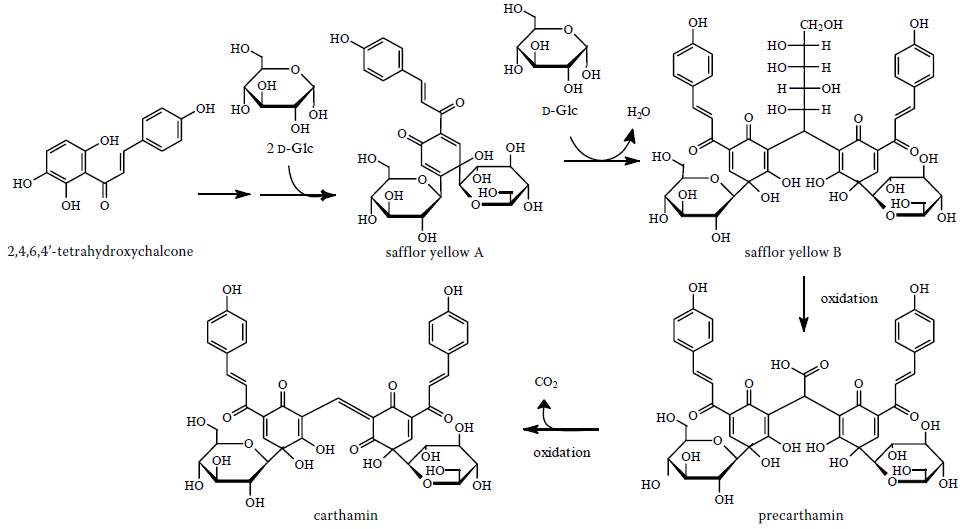Carthamin on:
[Wikipedia]
[Google]
[Amazon]
Carthamin is a natural red pigment derived from safflower (''
''Origin of cultivated plants.''
D. Appleton & Co.: New York, p. 164. Retrieved on 2007-09-25. It is used as a dye and a food coloring. As a
Carthamus tinctorius
Safflower (''Carthamus tinctorius'') is a highly branched, herbaceous, thistle-like annual plant in the family Asteraceae. It is one of the world's oldest crops; today, it is commercially cultivated for vegetable oil extracted from the seeds. ...
''), earlier known as carthamine.De Candolle, Alphonse. (1885.''Origin of cultivated plants.''
D. Appleton & Co.: New York, p. 164. Retrieved on 2007-09-25. It is used as a dye and a food coloring. As a
food additive
Food additives are substances added to food to preserve flavor or enhance taste, appearance, or other sensory qualities. Some additives, such as vinegar ( pickling), salt ( salting), smoke ( smoking) and sugar ( crystallization), have been used f ...
, it is known as Natural Red 26.
Safflower has been cultivated since ancient times, and carthamin was used as a dye in ancient Egypt
Ancient Egypt () was a cradle of civilization concentrated along the lower reaches of the Nile River in Northeast Africa. It emerged from prehistoric Egypt around 3150BC (according to conventional Egyptian chronology), when Upper and Lower E ...
. It was used extensively in the past for dyeing wool for the carpet industry in European countries, and in the dyeing of silk and the creation of cosmetics in Japan
Japan is an island country in East Asia. Located in the Pacific Ocean off the northeast coast of the Asia, Asian mainland, it is bordered on the west by the Sea of Japan and extends from the Sea of Okhotsk in the north to the East China Sea ...
, where the color is called ; however, due to the expensive nature of the dye, Japanese safflower dyestuffs were sometimes diluted with other dyes, such as turmeric
Turmeric (), or ''Curcuma longa'' (), is a flowering plant in the ginger family Zingiberaceae. It is a perennial, rhizomatous, herbaceous plant native to the Indian subcontinent and Southeast Asia that requires temperatures between and high ...
and sappan
''Biancaea sappan'' is a species of flowering tree in the legume family, Fabaceae, that is native to tropical Asia. Common names in English include sappanwood and Indian redwood. It was previously ascribed to the genus '' Caesalpinia''. Sappanwoo ...
. It competed with the early synthetic dye fuchsine
Fuchsine (sometimes spelled fuchsin) or rosaniline hydrochloride is a magenta dye with chemical formula C20H19N3·HCl.
as a silk dye after fuchsine's 1859 discovery.
Carthamin is composed of two chalconoid
Chalconoids ( Greek: χαλκός ''khalkós'', "copper", due to its color), also known as chalcones, are natural phenols
In organic chemistry, phenols, sometimes called phenolics, are a class of chemical compounds consisting of one or more hy ...
s; the conjugated bonds being the cause of the red color. It is derived from precarthamin by a decarboxylase. It should not be confused with carthamidin, another flavonoid.
The carthamin is biosynthesized from a chalcone
Chalcone is the organic compound C6H5C(O)CH=CHC6H5. It is an α,β-unsaturated ketone. A variety of important biological compounds are known collectively as chalcones or chalconoids. They are widely known bioactive substances, fluorescent materi ...
( 2,4,6,4'-tetrahydroxychalcone) and two glucose
Glucose is a sugar with the Chemical formula#Molecular formula, molecular formula , which is often abbreviated as Glc. It is overall the most abundant monosaccharide, a subcategory of carbohydrates. It is mainly made by plants and most algae d ...
molecules to give safflor yellow A and with other glucose molecule, safflor yellow B. The next step is the formation of precarthamin and finally carthamin.

References